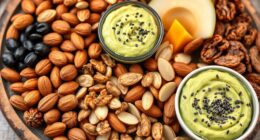A high-fiber diet with beans, whole grains, and vegetables helps support your digestive health, stabilize blood sugar, and boost your overall energy. Incorporate beans into your meals, choose whole grains like oats or brown rice, and fill half your plate with colorful vegetables. These choices boost gut health and prevent constipation. By making these foods regular parts of your diet, you’ll see positive changes in your health — more details lie ahead.
Key Takeaways
- Beans, whole grains, and vegetables are rich sources of soluble and insoluble fiber that support digestive health.
- Incorporating these foods helps regulate blood sugar levels and prevents spikes.
- These foods provide essential nutrients, antioxidants, and sustained energy for overall well-being.
- Gradually increasing intake of fiber-rich foods aids digestion and minimizes discomfort.
- A high-fiber diet with beans, grains, and vegetables promotes weight management and metabolic health.

Have you ever wondered how adding more fiber to your diet can boost your health? Increasing your fiber intake, especially from foods like beans, whole grains, and vegetables, can considerably improve your digestive health and help manage your blood sugar levels. When you consume fiber-rich foods, you’re giving your digestive system the support it needs to function smoothly. Fiber adds bulk to your stool, making it easier to pass and reducing the chances of constipation. This not only keeps your digestive tract healthy but also prevents issues like bloating and discomfort. Furthermore, a high-fiber diet encourages the growth of beneficial gut bacteria, which further supports digestion and boosts your immune system.
Adding more fiber from beans, grains, and vegetables supports digestion and helps regulate blood sugar.
In addition to aiding digestion, fiber plays an essential role in blood sugar control. When you eat foods rich in fiber, especially soluble fiber found in beans and oats, it slows down the absorption of sugar into your bloodstream. This gradual absorption prevents sharp spikes in blood glucose levels, which is particularly beneficial if you’re managing diabetes or trying to maintain steady energy levels throughout the day. By stabilizing your blood sugar, fiber helps you avoid sudden cravings and energy crashes, making it easier to stay focused and energized. Incorporating a variety of fiber-rich foods can also contribute to overall metabolic health and support weight management goals.
Beans are a fantastic source of both soluble and insoluble fiber, offering a dual benefit for your health. They’re not only filling and versatile but also packed with protein and essential nutrients. Including beans in your meals can help you achieve your daily fiber goals while providing a sustained release of energy. Whole grains like oats, brown rice, and whole wheat bread are equally important. They contain complex carbohydrates and fiber that take longer to digest, keeping you full longer and supporting stable blood sugar levels. Vegetables such as broccoli, carrots, and leafy greens add fiber, vitamins, and antioxidants to your diet, reinforcing your overall health.
The key is consistency. Incorporate these foods into your daily meals to build a balanced, high-fiber diet. Start your day with oatmeal topped with fruits and nuts, include beans or lentils in your lunch or dinner, and fill half your plate with a variety of colorful vegetables. Not only will this strategy improve your digestive health by promoting regularity, but it will also help you maintain better blood sugar control. Remember, increasing fiber gradually allows your body to adjust and minimizes any digestive discomfort. With time, you’ll notice improvements in your digestion, energy levels, and overall well-being, making a high-fiber diet an indispensable part of your healthy lifestyle.
Frequently Asked Questions
Can a High-Fiber Diet Cause Bloating or Gas?
Yes, a high-fiber diet can cause bloating or gas. When you increase fiber intake, your digestive system undergoes fiber fermentation, which produces gas as a byproduct. This gas production can lead to bloating and discomfort, especially if your body isn’t used to the sudden increase. To minimize these effects, gradually add fiber-rich foods to your diet and stay well-hydrated, allowing your system to adjust smoothly.
How Quickly Can I Expect to See Health Benefits?
You might start noticing some health benefits within a few days, but true results take time. As your fiber digestion improves gradually, you’ll feel more energetic and see better digestion and regularity. These gradual benefits develop over weeks, so stay consistent with your high-fiber diet. Patience is key—you’ll open the full advantages as your body adapts, making your journey toward better health both exciting and rewarding.
Are There Any Risks for People With Digestive Disorders?
If you have digestive disorders, you should be cautious. Fiber sensitivity can cause digestive complications like bloating, gas, or discomfort. Increasing fiber intake too quickly might worsen symptoms, so it’s best to introduce high-fiber foods gradually. Talk to your healthcare provider to tailor a diet plan that minimizes risks and helps you enjoy the benefits without triggering your digestive issues.
Can High-Fiber Foods Interfere With Medication Absorption?
Ever wonder if high-fiber foods can interfere with your medication? They can cause fiber-medicine interactions that slow down absorption, making your medicines less effective. Eating a lot of fiber, especially around the same time as your meds, might lead to absorption interference. To avoid this, try spacing out high-fiber meals from medication times or consult your healthcare provider for personalized advice.
What Are Some Easy Ways to Increase Fiber Intake Daily?
To increase your daily fiber intake easily, try snack swaps like replacing chips with popcorn or nuts. Incorporate more fiber-rich ingredients into your meals, such as adding oats to smoothies or using whole-grain bread. Explore simple recipe ideas like bean salads or veggie stir-fries. These small changes boost fiber without much effort, helping you stay healthy and satisfied throughout the day.
Conclusion
By choosing beans, whole grains, and vegetables, you can easily boost your fiber intake and support your overall health. Did you know that most people only get about half of the recommended fiber each day? Increasing your fiber intake can improve digestion, lower cholesterol, and even help with weight management. So, start incorporating more high-fiber foods into your meals today—you’ll feel better and enjoy the many health benefits that fiber has to offer!








